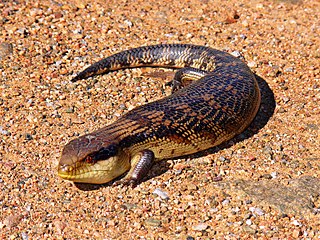
Skinks are lizards belonging to the family Scincidae, a family in the infraorder Scincomorpha. With more than 1,500 described species across 100 different taxonomic genera, the family Scincidae is one of the most diverse families of lizards. Skinks are characterized by their smaller legs in comparison to typical lizards and are found in different habitats except arctic and subarctic regions.

Coeranoscincus is a genus of skinks. They are endemic to Australia and found in eastern Queensland and northeastern New South Wales.

Cryptoblepharus is a genus of skinks, lizards in the family Scincidae. The genus contains at least 53 species.

Ophiomorus is a genus of Old World skinks. The limbs are either reduced or absent, depending on the species. They are sometimes known as limbless skinks or snake skinks. Members of the genus live under rocks or in burrows.
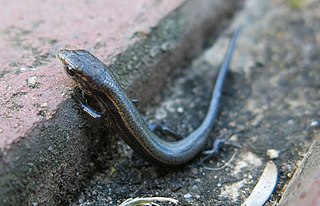
Panaspis is a genus of skinks, commonly called lidless skinks or snake-eyed skinks, endemic to Sub-saharan Africa.

George Albert Boulenger was a Belgian-British zoologist who described and gave scientific names to over 2,000 new animal species, chiefly fish, reptiles, and amphibians. Boulenger was also an active botanist during the last 30 years of his life, especially in the study of roses.
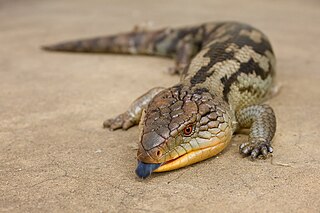
Blue-tongued skinks comprise the Australasian genus Tiliqua, which contains some of the largest members of the skink family (Scincidae). They are commonly called blue-tongued lizards or simply blue-tongues or blueys in Australia or panana in Indonesia. As suggested by these common names, a prominent characteristic of the genus is a large blue tongue that can be bared as bluff-warning to potential enemies. The type of predator/threat that is near will determine the intensity of colour present in the tongue. The tongue can also deform itself and produce a thick mucus in order to catch prey. They are relatively shy in comparison with other lizards, and also significantly slower due to their shorter legs.
Robert Friedrich Wilhelm Mertens was a German herpetologist. Several taxa of reptiles are named after him. He postulated Mertensian mimicry.

The short-limbed snake-skink is a species of burrowing short-limbed snake-skink that is endemic to the coastal areas and islands of New South Wales and Queensland, in Australia.

Legless lizard may refer to any of several groups of lizards that have independently lost limbs or reduced them to the point of being of no use in locomotion. It is the common name for the family Pygopodidae. These lizards are often distinguishable from snakes on the basis of one or more of the following characteristics: possessing eyelids, possessing external ear openings, lack of broad belly scales, notched rather than forked tongue, having two more-or-less-equal lungs, and/or having a very long tail. Every stage of reduction of the shoulder girdle —including complete loss— occurs among limbless squamates, but the pelvic girdle is never completely lost regardless of the degree of limb reduction or loss. At least the ilium is retained in limbless lizards and most basal snakes.

The white-lipped snake is a small species of venomous snake in the family Elapidae. The species is endemic to south-eastern mainland Australia and Tasmania.
Gyldenstolpe's worm skink, also known commonly as Gyldenstolpe's isopachys and Gyldenstolpe's snake skink, is a species of lizard in the family Scincidae. The species is endemic to Thailand.
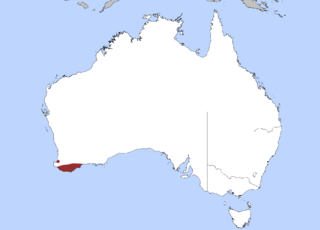
The short-nosed snake is a species of venomous snake in the family Elapidae. The species is endemic to Australia. Short-nosed snakes are endemic to swamplands and coastlands in the southwest of Western Australia, where they shelter in nests of stick ants, as well as dense rushes and reed tussocks. Short-nosed snakes are known to prey on small skinks mainly from the skink genus hemiergis, and small species of frogs.

Bougainville's skink is a species of skink, a lizard in the family Scincidae. This species is also commonly called the south-eastern slider and Bougainville's lerista.
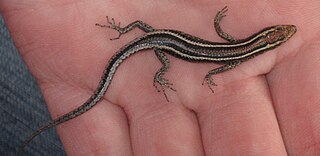
Cryptoblepharus virgatus, also commonly known as striped snake-eyed skink, cream-striped shinning-skink, wall skink, fence skink or snake-eyed skink is a skink commonly found in southern and eastern Australia. It is an active little lizard, and if threatened will often play dead to confuse the attacker.

The African striped skink, commonly called the striped skink, is a species of lizard in the skink family (Scincidae). The species is widespread in East Africa and Southern Africa. It is not a close relation to the Australian striped skink, Ctenotus taeniolatus.
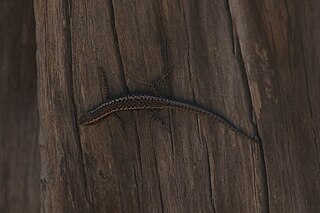
Cryptoblepharus australis, commonly called the inland snake-eyed skink, is a species of skink in the genus Cryptoblepharus.

Sphenomorphinae is a large subfamily of skinks, lizards within the family Scincidae. The genera in this subfamily were previously found to belong to the Sphenomorphus group in the large subfamily Lygosominae.

The saltbush Morethia skink, or more commonly referred to as saltbush skink, is a species of skink found in Australia. They are part of an 8 species genus of Morethia, which are all endemic to Australia. Akin to other members of the Morethia genus, saltbush skinks feature transparent disks as eye covers and eyelids which are stationary, along with specialised limbs which enable quick traversal of sand dunes. Taxonomically, the species was first classified by German explorer Wilhelm Karl Hartwig in 1871.

Crocosaurus Cove is a crocodile herpetarium and aquarium attraction located in an indoor-outdoor complex in the city district of Darwin, Northern Territory, Australia. Its main focus, as the facility's name indicates, is the tourism drawcard of northern Australia – crocodiles.


















